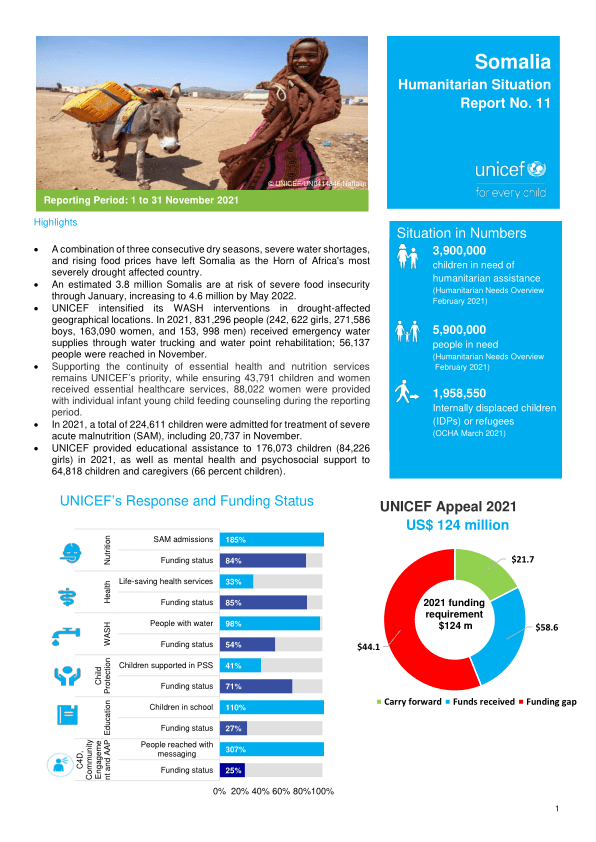Informing humanitarians worldwide 24/7 — a service provided by UN OCHA <!– TEMPORARY – COVID-19 – disabled – 2022/03/31 RW COVID-19 page: Find latest updates on global humanitarian responses –>
Find help on how to use the site, read terms and conditions, view the FAQs and API documentation.
Access your account or create a new one for additional features or to post job or training opportunities.
Latest humanitarian reports, maps and infographics and full document archive.
List of countries covered by ReliefWeb.
List of alerts, ongoing and past disasters covered by ReliefWeb.
List of organizations that are actively providing ReliefWeb with content.
Curated pages dedicated to humanitarian themes and specific humanitarian crises.
Open job opportunities in the humanitarian field.
Open training opportunities in the humanitarian field.
Somalia
Highlights
A combination of three consecutive dry seasons, severe water shortages, and rising food prices have left Somalia as the Horn of Africa’s most severely drought affected country.
An estimated 3.8 million Somalis are at risk of severe food insecurity through January, increasing to 4.6 million by May 2022.
UNICEF intensified its WASH interventions in drought-affected geographical locations. In 2021, 831,296 people (242, 622 girls, 271,586 boys, 163,090 women, and 153, 998 men) received emergency water supplies through water trucking and water point rehabilitation; 56,137 people were reached in November.
Supporting the continuity of essential health and nutrition services remains UNICEF’s priority, while ensuring 43,791 children and women received essential healthcare services, 88,022 women were provided with individual infant young child feeding counseling during the reporting period.
In 2021, a total of 224,611 children were admitted for treatment of severe acute malnutrition (SAM), including 20,737 in November.
UNICEF provided educational assistance to 176,073 children (84,226 girls) in 2021, as well as mental health and psychosocial support to 64,818 children and caregivers (66 percent children).
Funding Overview and Partnerships
As of November 2021, UNICEF’s Humanitarian Action for Children (HAC) appeal funding gap remains at 35 per cent from the required $124 million. Building on the humanitarian sector’s success in preventing famine in 2016 and 2017, more should be done to address the country’s current drought emergency, which would need major investment and strengthened humanitarian, development, and peace actor linkages. Thus, as needs continue to rapidly grow, UNICEF Somalia requires additional timely and flexible funding to respond effectively and efficiently to the ongoing crisis and ensure provision of lifesaving humanitarian assistances.
Situation Overview & Humanitarian Needs
More than 2.8 million people in 66 of Somalia’s 74 districts have been hit by a severe drought that has displaced over 133,000 people, mostly in the central and southern regions. According to the Food Security and Nutrition Analysis Unit’s (FSNAU) projections, an estimated 3.8 million Somalis are at risk of severe food insecurity through January, increasing to 4.6 million people by May 2022. An estimated 1.2 million children under the age of five years face acute malnutrition by July 2022, including 213, 400 likely to be severely malnourished.
Nutrition centres supported by UNICEF reported a 33% increase in the number of children with severe acute malnutrition admitted for treatment in November compared to the previous three months. SAM admissions in Bay, Bakool, Benadir, Gedo, and Middle Shabelle regions were reported to be high. The prevalence of child wasting has been reduced from 17% to 11% between 2017 and 20212 . Thus, a collective effort needs to be exerted to avoid a new increase in child wasting similar to what was observed in 2011 and 2017.
Water scarcity and drought conditions have contributed to increased water prices, leading to displacements, diarrhoearelated morbidity, and malnutrition in many parts of Somalia. The WASH cluster reported that Gedo, Bay, Bakol, Lower Jubba, Galgadud, Mudug, and parts of Bari, Nugaal, Sool, Sanaag, Togdheer, and Hiraan are the worst affected regions.
According to the education cluster, 1.4 million school-aged children are affected by the drought. Thus, 420,000 (45 percent girls) school-going children are at risk of dropping out of schools. Without timely action, learners’ absenteeism is likely to increase, resulting in more school dropouts. Furthermore, school dropouts put children at risk of recruitment into armed groups, sexual violence, child labour, and early marriage.
Conflict remains a core driver of displacement in Somalia. In 2021, 539,000 people were displaced due to conflict and insecurity3 . Furthermore, the children of Somalia continue to suffer from various forms of grave child rights violations.
On the 25th of November, a deadly bob attack near a school in Mogadishu killed eight people and wounded 17, including 13 children. Following the violent attack, UNICEF urges all parties to always ensure children’s safety and protect them from all forms of violence and harm.
Somalia
Somalia
Somalia
Somalia
ReliefWeb's blog
ReliefWeb Labs projects explore new and emerging opportunities to improve information delivery to humanitarians.
Learn more about ReliefWeb, leading online source for reliable and timely humanitarian information on global crises and disasters since 1996.
ReliefWeb's terms & Conditions.
Contact us.
Service provided by UN OCHA
OCHA coordinates the global emergency response to save lives and protect people in humanitarian crises. We advocate for effective and principled humanitarian action by all, for all.
ReliefWeb's Terms & Conditions.
© 2022 all rights reserved.
Home Uncategorized UNICEF Somalia Humanitarian Situation Report No. 11 (Reporting Period: 1-31 November 2021)...






















